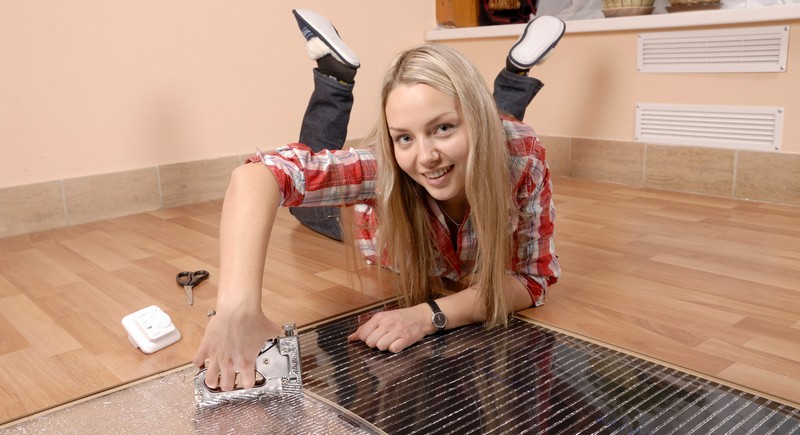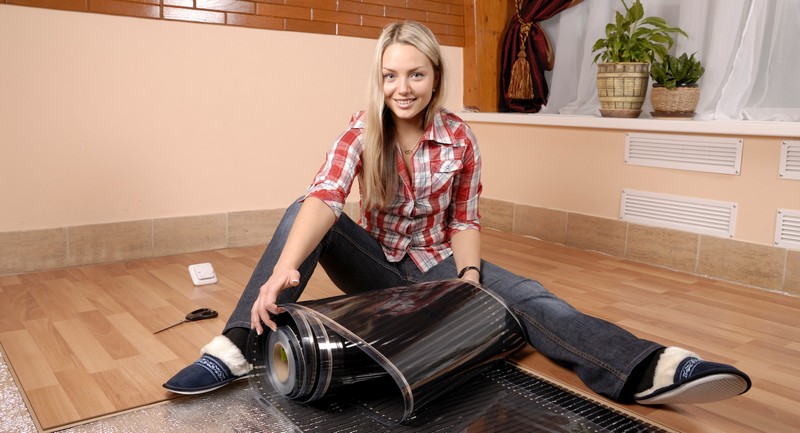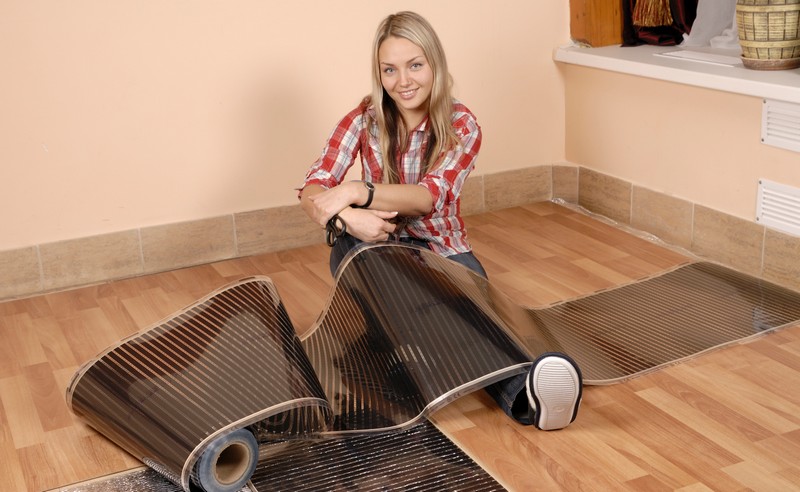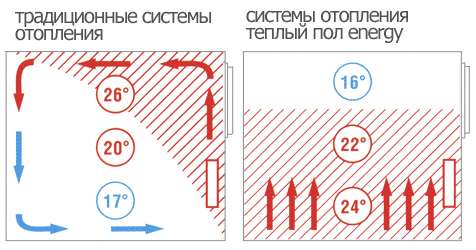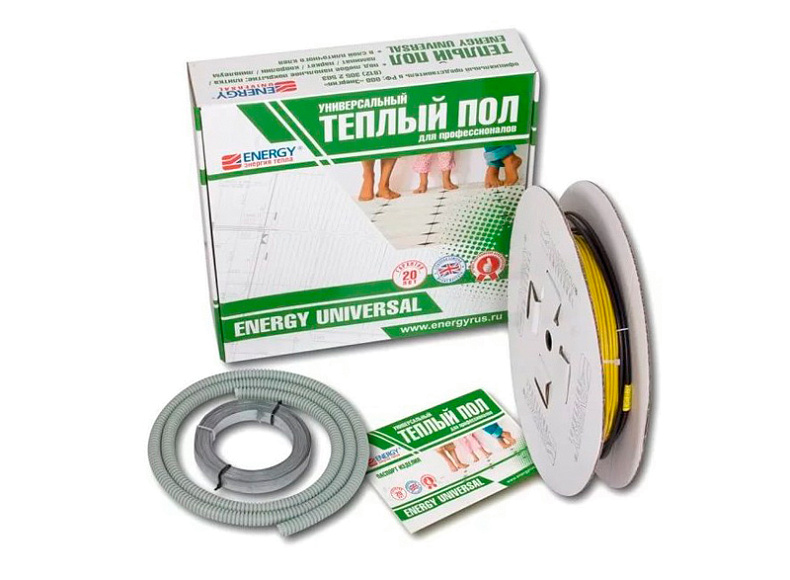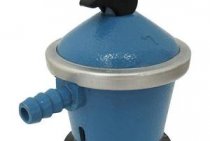Selection and location of the ENERGY MAT system
When choosing an ENERGY MAT underfloor heating system, be guided by the following requirements and recommendations:
- Plan the placement of the mats in such a way that there are no fixed objects and equipment above them (such as bathtubs, showers, toilets, refrigerators, washing machines and dishwashers, stoves, furniture with legs, etc.), as well as any other structures, obstructing the free circulation of air.
- If there are thermal expansion joints on the floor surface. The heating mats must be positioned so that the heating cable cannot pass through these seams.
- A separate heating mat with a thermostat must be used for each room. If there are floors with different types of flooring in the same room, use several heating mats with separate thermostats for each.
- Keep a distance of at least 5 cm from the heating mat to walls, furniture and other objects that prevent free heat emission into the air. The distance from the heating mat to other heating devices (risers, pipes for water heating and hot water supply, etc.) must be at least 10 cm.
- Calculate the heating area as accurately as possible and choose the right heating mat for each room.
- Remember that heating mats can only guarantee comfortable floor heating (the most suitable mode is from +26° to +28° C) and are intended for use in enclosed spaces with little heat loss.
- Consider the power of the installed heating mats, their load on the electrical network and the maximum permissible currents of the safety circuit breakers (for systems with a power of more than 2 kW, it is recommended to connect through a separate wiring and circuit breaker).
- To preserve the electrical insulation of the equipment, it is recommended to connect the heating mats through an RCD (Residual Current Device). When installing electrical systems for underfloor heating in wet rooms, the use of an RCD is mandatory.
- If possible, install thermostats for heating mats installed in damp rooms, hanging in these rooms.
Failure to comply with these rules leads to improper installation and operation of ENERGY MAT floor heating systems. as a result, the efficiency of using the system is seriously reduced, there are malfunctions in the operation of electrical equipment, and there is a risk of failure of the heating cable.
Features of the floor covering when using infrared heat-insulated floors
Usually, a warm floor based on infrared heating films is presented on the building materials market in the form of heating mats. These mats are laid directly under the floor covering, which can be used as ceramic tiles and porcelain stoneware, laminate, parquet, carpet, etc.
Infrared film has a convenient, quick and easy installation procedure. At the same time, at any time after laying the film, it can be collected and re-layed in another room, if the situation requires it.
Most often, infrared floor heating systems are installed under ceramic tiles or porcelain tiles, because. the ceramic surface is perceived by a person as cold. In addition, ceramic tiles have excellent heat transfer and are very resistant to significant temperature changes and prolonged heating. Also, infrared floor heating is quite often laid under basalt, granite and marble floor coverings.
In private houses and apartments, infrared film heating is most often installed in bathrooms and toilets, in kitchens, on balconies and in corridors.
Heating film advantages and disadvantages
Infrared warm floors have a number of serious advantages:
- excellent heat transfer due to the small thickness of the heating film;
- significant energy efficiency, tk.infrared mats have a small mass, therefore, the heating element immediately gives off thermal energy, does not accumulate it;
- large heat transfer area ensures even heat distribution;
- relatively low operating temperature and increased safety;
- high strength performance characteristics;
- low level of electromagnetic losses;
- durability.
And yet, the main advantage of infrared floor heating, which is based on a heating film, is low power consumption. In particular, if we compare the electricity consumption of an infrared film floor and a warm floor where a heating cable is used, then in the first case it is 3-4 times lower.
The next important factor in the use of film floor heating is its electromagnetic safety, since its operation eliminates the harmful effects of electromagnetic radiation on living organisms. For example, at a distance of 1 cm from an infrared film, the strength of the magnetic field created by it is less than 30% of the magnetic field strength on the surface of our planet. And at a distance of a few centimeters, it becomes simply insignificant. This makes infrared floor heating completely safe for use at home, including in children's rooms.
Another distinctive feature of the warm floor in general, and infrared, in particular, is a large heating area and a low location of the heating elements. These features contribute to a more rational and uniform temperature distribution in the horizontal and vertical planes compared to heating radiators concentrated in local areas above the floor level. Accordingly, the vertically uniform heat distribution allows lower operating temperatures to be exploited. The temperature in the room can be reduced by 2-3°C compared to heating radiators without changing the feeling of heat by the person. A temperature reduction of 2-3°C provides a 12% reduction in electricity consumption.
Of course, infrared heat-insulated floors are not ideal, they also have disadvantages. The main disadvantage of infrared floor heating is its high thermal inertia. Those. relatively long heating and cooling time. This parameter can be influenced by the use of one or another floor covering with different heat transfer rates.
Infrared film heating system
A relatively young, but quite promising and already popular, type of electric space heating is an infrared film underfloor heating. It uses a special heating film as a heating element.
Separately, I would like to say about the name. Quite often you can find such names as “infrared film”, “infrared heating film”, etc. These names are not entirely correct, since infrared radiation is the source for any heat, regardless of the heating element. Nevertheless, the name "infrared film" has long become a household name, so we will also use it.
Operating principle
Underfloor heating based on thin ENERGY heating mats is an electric cable heating system that provides an ideal temperature distribution over the floor surface in the room. It is designed both for rooms where a cement-sand (concrete) screed has already been made, and for those rooms where it is not possible to make it. Heating mats are a ready-made design that eliminates the procedure for laying and fixing a heating cable, so their installation is extremely simple. The heating cable ENERGY serves as a source of heat in the system.
The control of such systems is carried out using an automatic thermostat that is sensitive to changes in ambient temperature, which allows maintaining the set temperature with an accuracy of at least 0.4 ° C.At the same time, the floor temperature exceeds the air temperature by several degrees, so the air does not overheat and always remains fresh without changing the natural humidity of the room.
The system is silent, comfortable, environmentally friendly, and its service life is comparable to the service life of the building.
Durability and lack of maintenance
In terms of practicality, you can count on it. that heating mats will last as long as the room in which they are installed. Heating mats ENERGY do not require maintenance.
Quality, reliability, guarantee
The quality and reliability of ENERGY underfloor heating systems are confirmed by the international certificate ISO 9001:2000 and the Russian Certificate of Conformity No. ROSS CZ.AYA80. B04209. ENERGY cable products are guaranteed for 20 years.
Purpose of the ENERGY MAT kit
The ENERGY MAT underfloor heating system is a racing heating mat, which is a heating cable fixed with a constant pitch on a supporting grid 50 cm wide. ENERGY MAT is installed directly under the tile in a layer of tile adhesive, without increasing the construction height of the floor and providing comfortable heating of its surface.
Contents of the ENERGY MAT kit
The ENERGY MAT system kit consists of an ENERGY heating mat, a thermostat, a temperature sensor and a corrugated tube for the temperature sensor.
ENERGY heating mats use a two-core heating cable with fluoropolymer insulation of the heating core, protective (shielding) braid (14 soldered copper wires d 0.3 mm) and external PVC insulation. Cable diameter - 3.6-4.8 mm. The maximum linear power of the cable is 12 W/r.m. (with a supply voltage of 220 V).
How to lay sections
To install a "warm floor" it is recommended to make a project. The drawing is carried out in the passport of the heating device. The installation of a sectional floor begins with the installation of a thermostat. The section cable and temperature sensor wire will fit to it.
All conductors are placed in a corrugated tube using a probe. A groove is made for the tube in the floor and in the wall. Installation of sections is carried out on a flat, dry and clean surface.
The Energy system consists of the following layers:
- thermal insulation made of foam plastic 2 cm thick;
- if high-power sections are used to heat the room, then a 4 cm layer of concrete screed is laid on the insulation;
- foil layer 0.3 mm; use aluminum foil;
- lavsan film; it will protect the foil from overheating and reduce the effects of chemicals in the adhesive solution or screed;
- mounting tape;
- cable;
- strengthening the temperature sensor;
- plywood sheets;
- concrete screed or tile adhesive; layer depth 3-5 cm.

Before pouring mortar into the cable, all conductors must be connected to the temperature sensor. Be sure to test the system, check the resistance of the material. The resistance values are indicated in the passport for the heating section.
The heating system of the Energy brand is also used for central heating. The electric floor is turned on during the off-season, when the air temperature outside is low, but the centrals are not yet functioning. In winter, heating elements are used for zonal floor heating. This is especially true for the play area in the children's room.
Specifications of the heating cable
|
Operating environment temperature |
-30° to +70°С (minimum installation temperature: -5°С) |
|
Degree of protection |
IP67 |
|
Linear power |
12 W/r.p. |
|
Supply voltage |
220 V |
|
Cable outer diameter |
3.6-4.8mm |
|
Minimum cable bend radius |
eightfold (in relation to the diameter of the cable itself) |
|
Outer insulation color |
orange /yellow |
Parameters of heating mats ENERGY MAT-165
| mat type | Cable brand | Power, W | Length, m.p. | Area, m2 |
|
ENERGY MAT 0.50-70 |
LDTS 12 70-165 |
70 |
0,90 |
0.50 |
|
ENERGY MAT 0.80-130 |
LDTS 12 130-165 |
130 |
1.60 |
0.80 |
|
ENERGY MAT 1.30-210 |
LDTS 12 210-165 |
210 |
2.60 |
1,30 |
|
ENERGY MAT 1.65-260 |
LDTS 12 260-165 |
260 |
3,20 |
1.65 |
|
ENERGYMAT 2,14-340 |
LDTS 12 340-165 |
340 |
4.20 |
2,14 |
|
ENERGYMAT 2,58-410 |
LDTS 12 410-165 |
410 |
5,20 |
2,58 |
|
ENERGY MAT 3.00-500 |
LDTS 12 500-165 |
500 |
6.10 |
3.00 |
|
ENERGYMAT 3,90-560 |
LDTS 12 560-165 |
560 |
6.70 |
3.90 |
|
ENERGY MAT 4,20-670 |
LDTS 12 670-165 |
670 |
8,30 |
4.20 |
|
ENERGYMAT 5,10-810 |
LDTS 12 810-165 |
810 |
10,20 |
5,10 |
|
ENERGYMAT 6.10-1000 |
LDTS 12 1000-165 |
1000 |
12,30 |
6,10 |
|
ENERGYMAT 7,60-1210 |
LDTS 12 1210-165 |
1210 |
15.10 |
7.60 |
|
ENERGYMAT 8,80-1400 |
LDTS 12 1400-165 |
1400 |
17,60 |
8.80 |
|
ENERGY MAT 11.00-1800 |
LDTS 12 1800-165 |
1800 |
22.00 |
11,00 |
|
ENERGYMAT 13.30-2150 |
LDTS 12 2150-165 |
2150 |
26.60 |
13,30 |
|
ENERGYMAT 16.30-2600 |
LDTS 12 2600-165 |
2600 |
32,50 |
16,30 |
The temperature sensor is located in the floor, inside a special corrugated tube. This design allows, if necessary, to replace the sensor without disturbing the floor covering.
The kit may include an ENERGY Reg electronic thermostat or an ENERGY Pro electronic programmable thermostat.
Advantages and disadvantages of Energy products
A review of Energy heating mats would be incomplete without listing their strengths and weaknesses. The first ones include:
- Saving space in the room.
- Uniform heating of the surface.
- Simple and reliable control.
- Easy installation.
- Durability. The manufacturer's warranty period for all products is 20 years, the service life of heating cables is up to 50.
According to reviews, Energy underfloor heating has the following disadvantages:
- They create an increased load on the power grid.
- Consume a lot of electricity.
- Contribute to the increase of electromagnetic radiation.
- With strong heat, some types of flooring (for example, linoleum) can deform.
How to lay the system with your own hands
Installation of a warm floor according to the instructions consists of the following steps:
- In the wall, at a height of 1.5 m from the floor, a strobe is made for installing a thermostat. From this point down, it is necessary to punch a vertical groove 2x2 cm. A tube with a temperature sensor and the mounting ends of the heating cable are placed in it.
- The floor surface must be clean and level. If thermal insulation was laid on it before, then it must be filled with a layer of screed, wait until it dries completely, and only after that proceed with the installation of the heating system.
- The protective film is removed from the bottom of the mat and it is attached to the floor. A layer of tile adhesive no more than 5 cm thick is evenly poured on top.
Price
Despite the fact that Energy floor heating systems are produced in Europe, their prices on the domestic market are quite affordable. On average in Moscow, the cost of a Light heating mat is from 1,500 to 4,700 rubles per set, depending on the coverage area.
Light Plus will cost more: from 2,100 to 12,800. The price of Energy Cable 2,100 - 17,400. If you want to buy Mat warm floor, then be prepared to spend from 2,600 to 17,000 rubles per set. You can buy the Energy Universal system for 2,400 - 6,700.
Customer Reviews
“They installed the floors of the Energy Mat company in a private house. First they laid the corridor and the kitchen. A year has passed, our whole family was satisfied. The heat is evenly distributed, the main thing is to use the thermostat correctly, then the electricity bills are not as sky-high as they say. This year they made floor heating in the living room and children's room. All winter the children ran barefoot and finally cleaned up the carpets - a hotbed of dust.
Artem Troitsky, Voronezh.
“For the birth of the child, they made repairs in the bedroom. And since the central heating barely heats up, we decided to install floor heating. Bought the Light Energy system. It is compact, my husband easily mounted it himself. Now, instead of +16 in winter, the room is +22-24 °C. Baby is warm and comfortable
What is important, when my son began to crawl, without any fear let him go to the floor. The only thing I would like to receive bills for smaller amounts”
Veronika Astakhova, Moscow region.
“We had no heating in the bathroom except for a small coil on the wall. When the repair was started, on the advice of my son, a universal heating cable of the English production Energy was installed under the tile. The temperature immediately rose, it became comfortable and convenient. When we bought, we were very worried that it was powered by electricity and we would have to pay a lot for light. But the son taught him to reasonably regulate the heating temperature, and there was no large increase in electricity consumption. At least we have enough pensions.”
Vasily, Yaroslavl.
Installation instructions Energy Mat
The installation is carried out according to the following scheme.
Work begins by determining the location of the thermostat and sensor. It is desirable to place the first one 1.2–1.5 m above the floor level.The location of the sensor, as you know, is associated with the location of the thermostat. Corresponding curtains are cut under them on the floor and on the wall.
- The surface of the floor also needs preparation. It must be leveled and compacted, it is necessary to remove cracks and chips from it, all objects with which there is a risk of damage to the heating system. The surface is vacuumed and wiped with a damp cloth. The absence of dust increases the adhesion of plitonite.
- A detailed scheme of the layout of the mat according to the shape of the sections is drawn up.
On a note
If the floor was insulated, then a small layer of screed is first poured on top of it, about 3 cm, and only then the heating mat is mounted.
- Install the mounting tube with the temperature sensor. The edge remaining on the floor is sealed, the second is taken out through the curtain to the thermostat. The curtain is filled with glue. The location of the sensor must be marked both on the floor and on the diagram.
- The surface of the base under the mat is treated with a deep penetration primer.
Lay the mat on the plane of the floor in accordance with its shape. If necessary, it is cut or rotated in the right direction.
All this is done with great care so as not to damage the heating element. After removing the protective film from the bottom of the mat, finally fix it to the floor
Now, when filling, it will in no case be displaced.
The cold ends of the system are brought out to the connection box and the floor surface is poured with a solution of tile adhesive. The thickness of its layer should not be more than 5 mm. The solution must be of such a consistency that, on the one hand, proper contact with the cable surface is ensured, and on the other hand, cracks or air cavities in the adhesive layer must be completely excluded.
Energy Universal
For a "warm floor" heating system, it is recommended to install cable sections. They are a cable of limited length. Sections differ in power, length and diameter of the conductor. Depending on the diameter of the cable, a certain floor covering is used. Energy Universal sections are universal. They are laid under any facing, in any room.
Characteristics of the heating system:
- two-core cable;
- the heating core is insulated with fluoropolymer material;
- the shielding layer is represented by a galvanized copper braid;
- the screen covers the foil layer; external insulation made of PVC;
- cable diameter 2.5-3.5 mm; the conductor is selected in accordance with the size of the room and the required intensity of heating;
- the section is connected to a 230 V electrical network;
- the cable heats up to 70 0С; temperature is working;
- power per 1 linear m - 10 W;
- recommended materials for finishing the floor: laminate, parquet, tiles of any variety and texture, carpet;
- the section is installed in a concrete screed or under a concrete screed;
- any design is acceptable in the room;
- furniture without legs can be installed on the heated surface; conductor locking will not happen;
- if necessary, you can rearrange the furniture in the room.
For Energy Universal, the following modifications of thermostats are purchased: Energy TK04 with mechanical control, Energy TK02 with a liquid crystal screen, Energy TK03 with software. The devices are connected to a 220 V system. For a certain heating area, sections from 160 W to 2600 W are selected.
Heating systems are installed not only in the premises of the house, but also in greenhouses, greenhouses. In the passport for the heating equipment there is a table according to which, according to the heating area of the room, you can select the section of the required power.
About products
The specificity of the company's products is to complete the systems with domestic materials and foreign-made heating elements. In particular, the cable in all models is produced by the British company Lytellton Limited. Mats are made of heat-resistant polymeric material with mechanical strength and low thermal conductivity.
Currently, the company offers a choice of several systems that differ in scope:
- Use as an auxiliary heating source in the presence of the main heating. To solve this problem, you can use thin mats or single-core cables mounted on a mounting tape.
- Installation of a powerful heating cable in rooms without additional heating devices. The best choice is models with a two-core cable of a large cross section. These can be both heating mats and separate sets for arbitrary laying of heating elements.
- Outdoor floor heating (terrace, open area).
You can decide on the choice of one or another type of underfloor heating only after familiarizing yourself with the full range of the company.
products
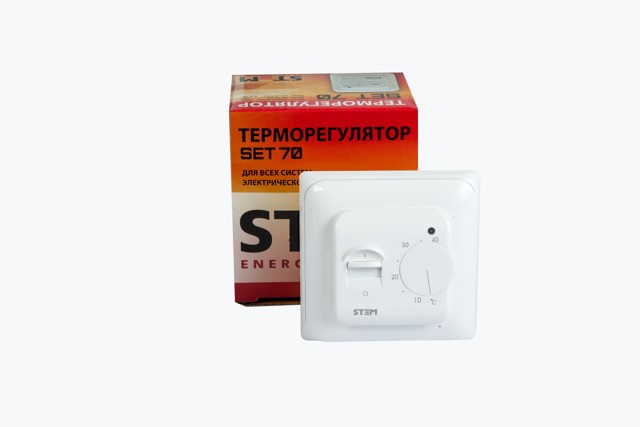
Simple, convenient, reliable classic mechanical thermostat.
849 r.
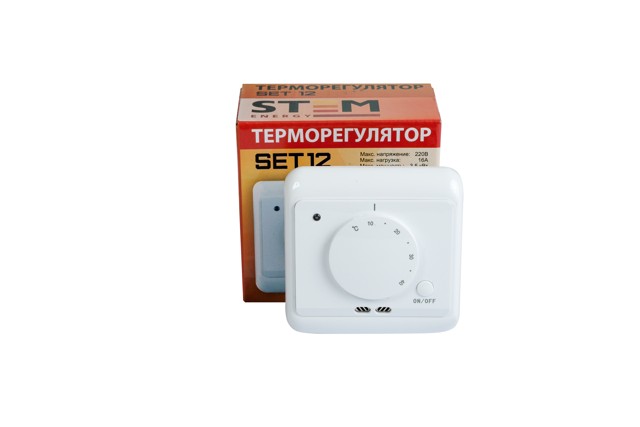
Mechanical thermostat with remote floor temperature sensor.
1 009 r.
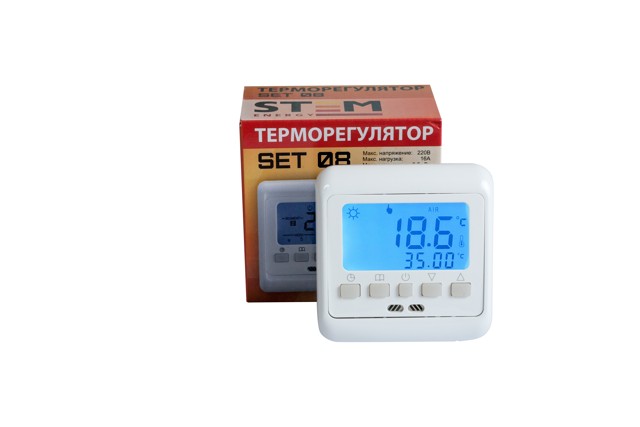
Programmable room thermostat with remote floor temperature sensor and built-in air temperature sensor.
2 103 rubles
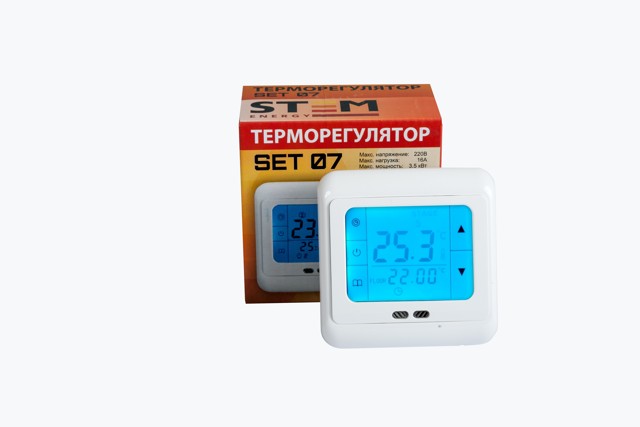
Touch programmable temperature controller with remote floor temperature sensor and built-in air temperature sensor.
2 343 r.
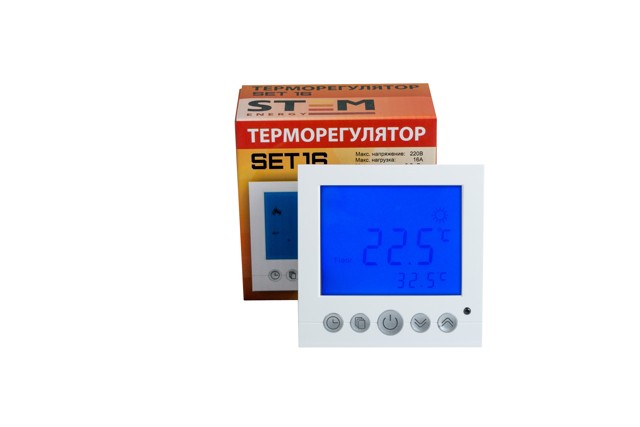
Programmable thermostat with remote floor temperature sensor and built-in air temperature sensor.
2 472 r.
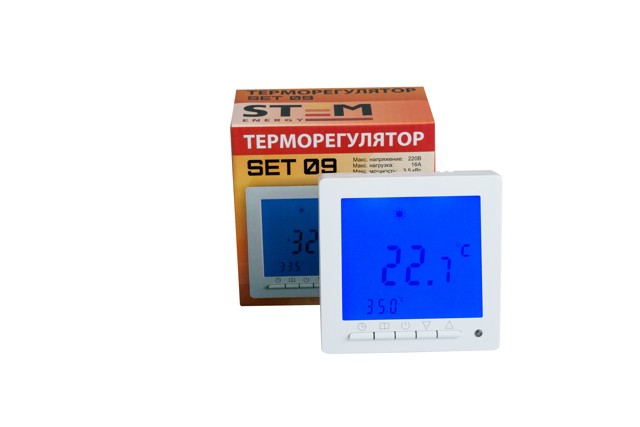
Programmable thermostat with a large screen, remote floor temperature sensor and built-in air temperature sensor.
$2,181
 Temperature controller SET 04 (programmable)
Temperature controller SET 04 (programmable)
Programmable thermostat with screen, remote floor temperature sensor and built-in air temperature sensor.
$1,739
 Temperature controller SET 03 (programmable)
Temperature controller SET 03 (programmable)
Programmable thermostat with screen, remote floor temperature sensor and built-in air temperature sensor.
$1,987
 Temperature controller SET 02 (programmable)
Temperature controller SET 02 (programmable)
Programmable thermostat with screen, remote floor temperature sensor and built-in air temperature sensor.
2 795 r.
 Thermostat SET 10 (programmable)
Thermostat SET 10 (programmable)
Programmable thermostat with a large screen, remote floor temperature sensor and built-in air temperature sensor.
1 720 rubles
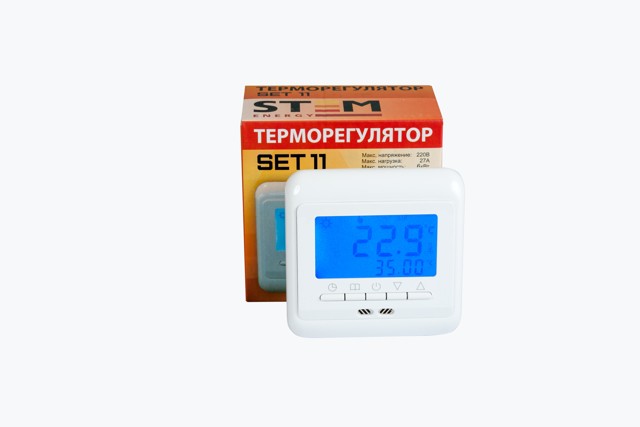
High power programmable thermostat with remote floor temperature sensor and built-in air temperature sensor.
2 418 r.
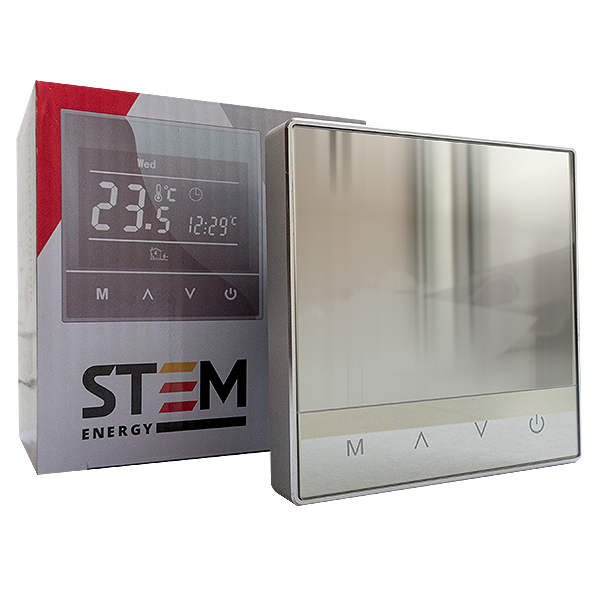
Stylish design, white backlit touch display turns into a mirror in standby mode. Automatic and manual adjustment mode.
$6,043
 Thermostat-socket SET 20 (mechanical)
Thermostat-socket SET 20 (mechanical)
Simple, convenient, reliable mechanical thermostat in the socket.
$1,853
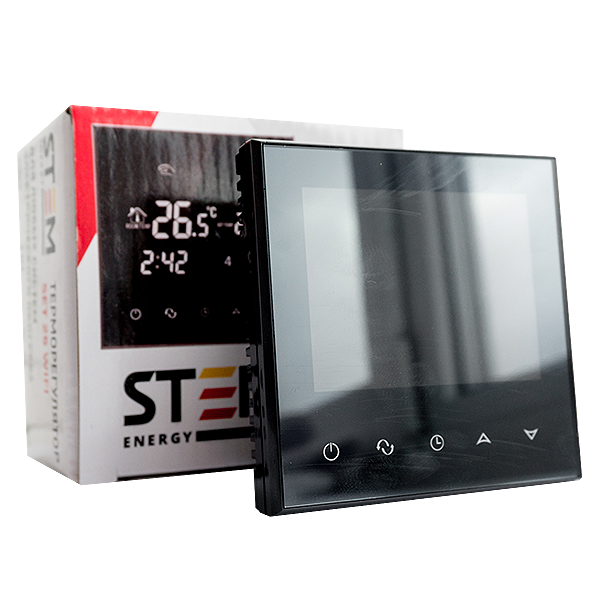
The SET 25 thermostat with Wi-Fi for underfloor heating allows you to control the heating section, mat or foil via a smartphone application. A convenient solution for those who appreciate comfort, save energy and know how to manage their time rationally.
6 436 rubles
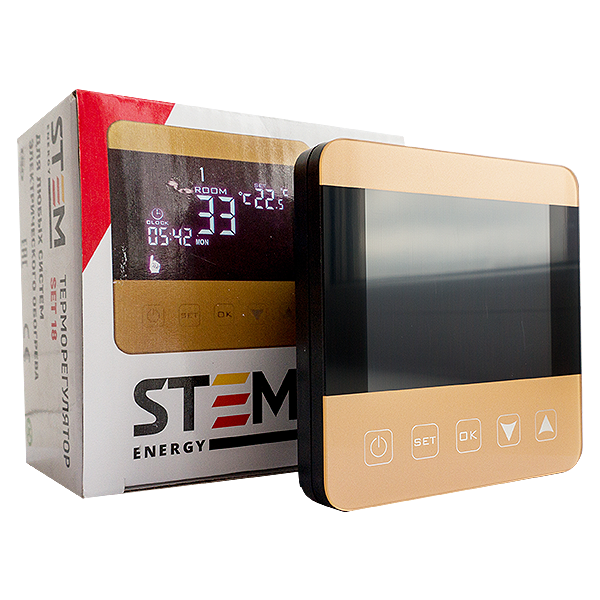
Stylish design, touch screen. Two temperature sensors: built-in to measure the air temperature in the room and remote on the wire to measure the floor temperature.
3 861 rubles
Installation of programs for the thermostat ENERGY TK03
The thermostat TK03 has the ability to set 4 programs for the days from Monday to Friday (1-5) and 2 programs for Saturday and Sunday (6-7). For each program, the start time is set from 00:00 to 23:50 in increments of 10 minutes and the required t ° value in the range from 5 ° C to 40 ° C in increments of 0.5 ° C. The minimum running time for each program is 10 minutes.
Factory setting:
|
Day of the week |
Program |
Program start time |
Temperature value |
|
Monday-Friday (1-5) |
Morning |
6:00 |
25°C |
|
Day |
8:00 |
20°C |
|
|
Evening |
19:00 |
25°C |
|
|
Night |
23:50 |
20°C |
|
|
Saturday - Sunday (6-7) |
Morning |
9:00 |
35°С |
|
Night |
23:50 |
20°C |
- To change the factory setting, press the button in hole P with a thin, hard, blunt object - the start time of the first program - “Morning” will flash.
- Pressing the “up” button increases (“down” - decreases) the set time value by 10 minutes (holding the button for more than 2 seconds activates the high-speed mode of increasing / decreasing the value of minutes). Having set the desired time value, press the "inter" button - the t ° value set for the first program will flash;
- Pressing the “up” button increases (“down” - decreases) the set t ° value by 0.5 ° С (holding the button for more than 2 seconds activates the high-speed mode of increasing / decreasing the t ° value). After setting the desired t° value, press the button - the start time of the second program will flash.
- Set the desired start time and t° for each program of the remaining five programs in the same way. After setting the t° value for the last program, the display will return to normal mode.
Early start.
The TK03 thermostat has an additional option "Early start", which is activated automatically: based on the data received on the previous day of work, the thermostat will independently determine how many minutes (but not more than 60) before the start time you set for the "Morning" program, you need to supply power to the heating cable and start the heating process so that by the time the Morning program starts, the floor surface temperature has reached the value you set.
Manual setting of t°.
Manual setting allows you to temporarily set a t° value different from the set value for the current program:
- When the display is in normal mode, press the button - the set t ° value for the current program will be displayed;
- Pressing the button increase (decrease) the set value of t° by 0.5°C. (holding the button for more than 2 seconds activates the high-speed mode of increasing decreasing the set value of minutes). After setting the desired t° value, press the "escape" button - the display will switch to the Manual setting mode, the "hand" icon will appear.
The manually set temperature will remain in effect until the start of the next program or until the button is pressed and held for 2 seconds.
Switching off the thermostat.
In normal display mode, press and hold the ON/OFF button for three seconds. — the display goes out, all buttons except ON/OFF are blocked, the power supply to the heating cable is turned off.
Instruction manual for thermostat Energy TK03
